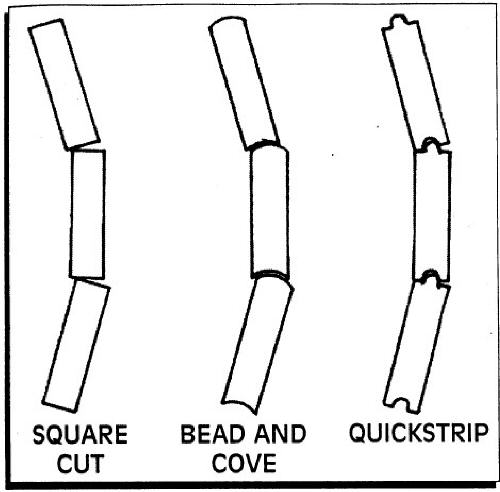|




STRIP
PLANKING
BEYOND THE BASICS
A recent edition of Australian Amateur Boatbullder
contained an article 'Composite Strip Planking Basics'. There are a number
of difficulties involved in the conventional strip planking described,
which are generally ignored and left to the unfortunate boat builder to
discover the hard way. Since BoatCraft Pacific have been involved in
developing techniques to alleviate these difficulties, we will explain
these more modern and labour saving methods of strip planking.
The difficulties builders encounter with conventional strip planking
are:
1. As you plank around the bilge of the boat,
differential twist between each plank and the next ea uses them to spring
sideways. '[his can produce steps between each plank. These steps can be
reduced, but rarely eliminated, by (tediously) fixing lots of transverse
pimood strips over the planks to try to force them down, or you will just
have to sand them away ro create a smooth surface for the fibreglass
lamination. Either way, there's hours of sanding, which is not much fun
especially inside a small craft like a canoe. This problem applies whether
you are using simple square sawn strips or bead and cove strips (see
diagram).

2. As was pointed out
previously, one of the more time consuming jobs is applying epoxy glue to
the strip edges.
3. IT your boar is
longer than 5m (16ft) it will be absolutely necessary to scarf join every
plank (other than few shorter ones near the keel) before you start
planking. Unfortunately, Western Red Cedar is no longer available in
lengths longer than 5.4 or 5,7m, which is about the length around the hull
of a 5m boat.
Enter QUICKSTRIP strip
planking profiles.
Quickstrip is a modified
tongue and groove profile, designed by Brisbane boat budder Christopher
Tuck, and manufactured exclusively by Oregon Sales. It has been engineered
to allow adjacent planks to rotate relative to each other by more than 15
degrees without losing register and slipping sideways. So Quickstrip
eliminates the steps on the surface and reduces sanding to a mere
smoothing job before fibreglassing. Of course, as with square cut planks,
the gaps between planks around the outside of the hull must be filled with
an epoxy sanding compound all over the surface, and wiping clean. Only a
light sand is required before glassing.
The
second benefit of Quickstrip is that scarfing the planks is no longer
necessary. The planks are simply butted up to each other and glued. The
butt joins can be cut at 90 or preferably at 45 degrees. The tongue and
groove each side of the plank holds the butt ends in perfect alignment
without any need to align and scarf join them beforehand.
The final improvement is the use of BoatCraft's Purbond adhesive. This
is a single pack moisture curing polyurethane adhesive, which expands
slightly as it sets so fills the small gaps between the Quickstrip (or any
other) profiles. A very small bead of Purbond is simply squeezed along
each groove, spread with a scrap of plank, and the plank is [lien ready to
be fixed. It is much easier and more time saving than mixing and spreading
epoxy, even when spreading onto several planks at once in a glueing
fixture. Purbond is also easier to clean up, since it does not blunt edge
tools like epoxy does. So you can plane down the exterior of the hull to
fair it, instead of creating vast clouds of sanding dust.
Purbond is
also much more economical. We have had builders strip planking the hulls
of large boats at a fraction of the cost of epoxy - a 9m strip planked
catamaran needs as little as 10 litres of Purbond, costing a mere $180!
Finally a word of caution. Of course, there are cheaper copies of
Quickstrip around. Router cutters can be purchased to mill your own
profiles. So far, we have not seen one which has been properly designed
and engineered to the accuracy standards that our tool makers acheived.
The result is that you, the long suffering boat builder, simply get to do
more sanding, just like the (bad) old days. Buyer Beware! You get just
what you pay for.
Quickstrip profiles are
stocked and distributed by BoatCraft Pacific. For further information on
Quickstrip techniques,
supply of Quikstrip in Western red Cedar,
Purbond adhesive, or Bote-Cote epoxy products call
BoatCraft Pacific on (07) 3806 1944 or any BoatCraft distributor.
Enquiries /font>
Please call Boatcraft Pacific
07 3806 1944 ( +617 3806 1944) for how to contact your nearest reseller.
Copyright Boatcraft Pacific Pty.
Ltd. | 
